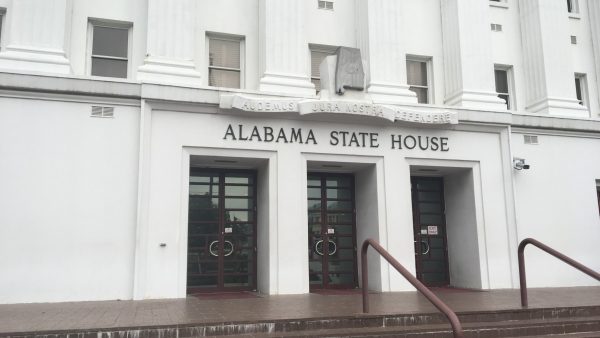Asian Soybean Rust
It’s a sunny but cold Mid November Saturday in Dothan. The cold is what’s
killing a big bed of kudzu between cotton fields and the passing cars on
highway 431. But not all the plants are dead, and some of those are
host to a devastating little devil-the Asian Soybean rust spore. The spore sucks
the life out of kudzu, which wouldn’t bother many horticulturalists… but
the spore also has a taste for another legume – Soy beans. Infected plants can’ t mature-meaning, smaller harvests and smaller revenues for farmers. And it’s
difficult to contain the fungi because it moves with the wind.
The spore originates in Asia and took the scenic route over to the states,
stopping off in Africa and South America. Before the diseased arrived, climatologists believed it would take the perfect storm to scoop up the spores in
Brazil and carry them over the ocean before dumping them along the Gulf Coast.
That perfect storm came in the form of Hurricane Ivan, which dumped millions upon millions of rust spores in the southeast. Shortly after the storm, scientists detected spores in Louisiana. Soon after, they found them in Georgia, Alabama, Florida, and within a year the range of the spores stretched from Texas to North Carolina.
“It’s certainly important to know the where the spores are and how widespread the disease is.
That’s Dr. Robert Wisner, an economist and grain-marketing specialist at
Iowa State University. Wisner sits on the Iowa Soybean Rust Task Force, which is
charged with protecting that state’s $2 billion soy crop. So far rust spores haven’t made their way up to the Midwest. But Wisner says eventually they will, and farmers in Iowa need to know what’s going on in Alabama and the rest of the southeast.
“That gives us some clues as to the likely hood of those spores blowing in to Iowa.
Currently, farmers fight the disease with expensive fungicides that have to
be applied at a specific time to be effective. If a farmer is late to spot the rust, and has to spray the crops twice, that could eliminate any profit the soybeans would have been brought in. So while climatologists watch the wind patterns, plant pathologists like Auburn University’s Ed Sikora are watching the ground. Sikora is a leading figure in the fight against spores. He’s also set the record for the most spore discoveries in a single day.
“My competitive juices were running because Georgia was getting ahead of us. So over about a 24-hour period, I traveled up the eastern edge of Alabama going county to county and looking at kudzu patches and soybean fields and I managed to find rust in ten counties along that edge.
The Alabama-Georgia Border is ground zero for the rust spores, and there’s
lots of friendly competition between scientists from the two states. University of Georgia researchers say they were in awe of Sikora’s mad dash to track the spore. But the Georgia researchers are also gaining attention for their work in the fields.
“I think the only thing more boring than rating plots is you watching me rate plots.”
He may think it’s boring, but Dr. Bob Kemeriat’s work could save farmers billions of dollars. On a windy weekday afternoon, Kemeriat is in Attapulgus, Georgia, looking over soy leaves. He’s interested in how quickly the plants succumb to the
fungi.
“You can see it starts in the lower canopy; a few leaves are
dropping, as you move up to towards the top of the plant it’s not there.
Kemerait is searching for the spores-which look like little balls of rust
you’d find on an old washing machine or tin can.
“Unless you knew what you were looking for, you’d never see it. Especially if you were scouting a field driving by in your pick-up truck, it’d be tough.
Kemeriat is joined in the field by Dr. Leila Skonyers. They’re searching with hopes of finding what they call the Holy Grail of soy – a rust proof plant.
“So far we haven’t been able to find that Holy Grail plant. Most
Legumes we come across have some sort of susceptibility to rust. But if we do
find it will be of great help to the grower.
But for now, the biggest help to farmers isn’t scientists with a friendly
AL-GA rivalry. It’s mother nature. Growers are hoping it gets cold enough in
places like Dothan, to kill the kudzu, and the soybean rust spore.
Florida’s 6-week abortion ban will have a ‘snowball effect’ on residents across the South
Abortion rights advocates say the ban will likely force many to travel farther for abortion care and endure pregnancy and childbirth against their will.
Attitudes among Alabama lawmakers softening on Medicaid expansion
Alabama is one of ten states which has not expanded Medicaid. Republican leaders have pushed back against the idea for years.
Birmingham is 3rd worst in the Southeast for ozone pollution, new report says
The American Lung Association's "State of the Air" report shows some metro areas in the Gulf States continue to have poor air quality.
Why haven’t Kansas and Alabama — among other holdouts — expanded access to Medicaid?
Only 10 states have not joined the federal program that expands Medicaid to people who are still in the "coverage gap" for health care
Once praised, settlement to help sickened BP oil spill workers leaves most with nearly nothing
Thousands of ordinary people who helped clean up after the 2010 BP oil spill in the Gulf of Mexico say they got sick. A court settlement was supposed to help compensate them, but it hasn’t turned out as expected.
Q&A: How harm reduction can help mitigate the opioid crisis
Maia Szalavitz discusses harm reduction's effectiveness against drug addiction, how punitive policies can hurt people who need pain medication and more.







